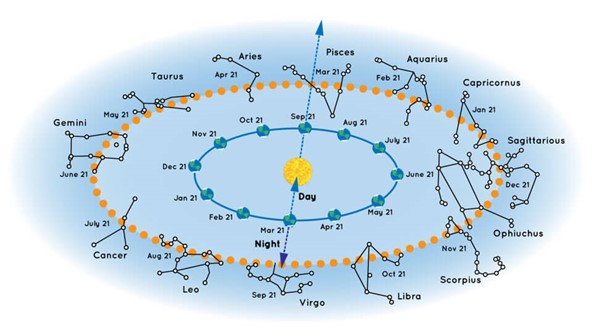Zodiac Constellations Facts: Everything About the Constellations Along the Ecliptic
What Is the Zodiac?
The word zodiac comes from the Greek zōidiakòs kýklos which means “circle of little animals.” The zodiac is a region of the sky with a ring of constellations that lie along the ecliptic. The ecliptic is important because it is the Sun’s apparent path relative to the stars in a year. The zodiac constellations extend about 8° north and south of the ecliptic.
In the past, the Sun’s movement through the ecliptic allowed people to determine the time of year as well as the seasons. It is very useful in mapping the sky and the stars. The constellations of the zodiac hold great significance to many cultures as well.
In the solar system, the planets and moons lie close to the plane of the ecliptic. This is why, from our perspective on Earth, we can see planet conjunctions in our sky. These celestial objects are very distant from each other but they can appear close together in the sky because they lie in the same plane.
To understand the ecliptic better, let us take a look at Pluto’s orbit.
Pluto, which is now reclassified as a dwarf planet, lies far off the ecliptic. Its orbit does not lie in the same plane as the main planets. Below, Pluto’s orbit (in red) takes it far above and below the solar system plane.
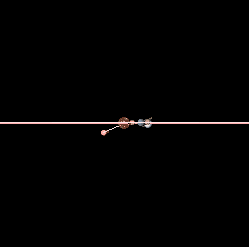
Pluto crosses the ecliptic twice in its 248 Earth years of orbital period. The most recent Pluto-ecliptic crossing was on October 24, 2018. It will not cross this plane again until December 11, 2178.
Astronomy vs Astrology
The zodiac constellations are not only important for astronomy and science, but it has also become the basis of astrology. Each zodiac constellation, except Ophiuchus, have their own corresponding zodiac signs.
In astronomy, the zodiac is important because the ecliptic passes through it. It helps us understand the Sun’s movement better. And since the planets, moons, and other solar system bodies lie near this plane, it also reveals our place in the celestial sphere through the ecliptic coordinate system.
On the other hand, horoscopic astrology has become so prominent today that when people hear the word “zodiac,” they think of their star signs, not the constellations.
Astrology has its roots in the ancient past but it continues to be of interest in the present. The position of the Sun and the planets along the ecliptic is interpreted differently from the scientific perspective. It is believed that the movements of these celestial bodies hold meanings and can affect people’s lives.
In Astronomy: The 13 Zodiac Constellations
There are 88 modern constellations recognized by the International Astronomical Union (IAU). They are grouped into 8 constellation families according to common themes, origins, proximity, and even mythologies.
Constellation Families
- Ursa Major Family
- Zodiac Family
- Perseus Family
- Hercules Family
- Orion Family
- Heavenly Waters
- Bayer Family
- La Caille Family
How Many Zodiac Constellations Are There?
There are 13 zodiac constellations. These are:
- Aries
- Taurus
- Gemini
- Cancer
- Leo
- Virgo
- Libra
- Scorpio
- Ophiuchus
- Sagittarius
- Capricorn
- Aquarius
- Pisces
It is most commonly thought that there are only 12 zodiac constellations. The often forgotten one is no other than Ophiuchus the Serpent Bearer. The confusion stems from the fact that this constellation has no corresponding astrological zodiac sign.
However, by looking back at the definition that “the zodiacs lie along the ecliptic,” technically, there are 13 constellations in this group. Though, some sources classify Ophiuchus under the Hercules constellation family.
To make it easier, it is important to note that the topic of zodiac constellations is under astronomy. Meanwhile, the zodiac signs and horoscopes are part of astrology.
Remember:
There are 13 zodiac constellations, but only 12 zodiac signs.
Zodiac Constellations and the Zodiac Signs
Every now and then, there would be stories circulating that NASA has discovered the 13th zodiac sign.
However, NASA is a science agency that deals with science stuff, not astrology. While this could come as a surprise to some, those familiar with astronomy know that the Sun passes through 13 constellations over the course of a year.
The signs of the zodiac were created because humans have long been drawn to the stars. It originated in Babylonian astronomy around 1500 BC, which we know as astrology today. They based these signs on the constellations in the Earth and Sun’s path. It was also the Babylonians that decided to have 12 zodiac signs, leaving out Ophiuchus.
According to NASA, the Babylonians opt for 12 signs as it corresponds to their 12-month calendar. Also, the Sun does not spend an equal amount in each constellation. For example, it stays 45 days in Virgo and only 7 days in Scorpius.
| Name | Zodiac Constellations based on IAU boundaries | Solar Stay | Zodiac Signs (Dates) |
|---|---|---|---|
| Aries | 19 April – 13 May | 25 days | 21 March – 19 April |
| Taurus | 14 May – 19 June | 37 days | 20 April – 20 May |
| Gemini | 20 June – 20 July | 31 days | 21 May – 21 June |
| Cancer | 21 July – 9 August | 20 days | 22 June – 22 July |
| Leo | 10 August – 15 September | 37 days | 23 July – 22 August |
| Virgo | 16 September – 30 October | 45 days | 23 August – 22 September |
| Libra | 31 October – 22 November | 23 days | 23 September – 23 October |
| Scorpius | 23 November – 29 November | 7 days | 24 October – 21 November |
| Ophiuchus | 30 November – 17 December | 18 days | N/A |
| Sagittarius | 18 December – 18 January | 32 days | 22 November – 21 December |
| Capricornus | 19 January – 15 February | 28 days | 22 December – 19 January 20 |
| Aquarius | 16 February – 11 March | 24 days | 20 January – 18 February |
| Pisces | 12 March – 18 April | 38 days | 19 February – 20 March |
To make things in sync with their calendar, the Babylonians assigned an equal number of days to each zodiac sign. Each sign occupies 30 degrees of the zodiac and, on average, has about 30 days intervals.
Map of the Zodiac Constellations
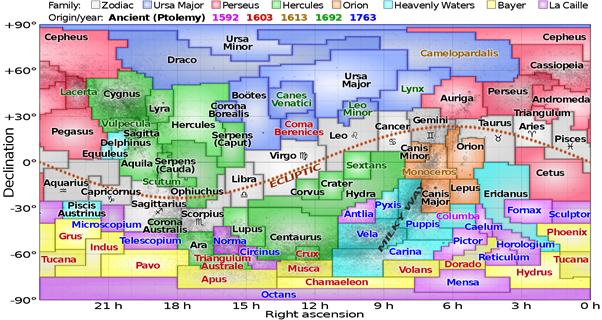
Constellation families are grouped together because of common characteristics. While others share the same origins and or mythologies, the zodiac is grouped because the Sun passes through them. The belt-like zodiac passes through other constellations families, sometimes cutting them in half.
The Four Cardinal Signs
The four cardinal signs indicate the start of the seasons.
- Aries: spring
- Cancer: summer
- Libra: fall/autumn
- Capricornus: winter
The season changes as the Sun enters the regions of the cardinal signs. While this may be the case in the past, the precession of the Earth has caused some changes. The precession of the equinoxes is the slow change of the orientation of the Earth’s rotational axis over time. This is the result of the Earth wobbling like a spinning top.
Instead of Aries, at present, spring kicks off when the Sun enters Pisces and the autumnal equinox has now moved to Virgo.
The Zodiac Constellations Up Close
Aries Constellation
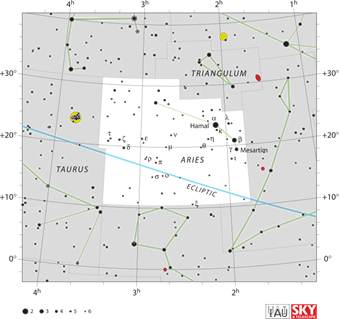
The constellation of Aries represents the celestial ram. It is located in the northern celestial hemisphere. It is the 39th largest constellation among the 88 modern constellations recognized by the International Astronomical Union (IAU).
The Aries constellation is not prominently bright. Its brightest member is the orange giant Hamal, a second magnitude star. Other notable stars in the constellation are Sheratan, Mesarthim, and 41 Arietis. Though not especially bright, many stars in Aries shine with 3 to 5 apparent magnitude. This means we can see them in the naked eye.
The spiral galaxy NGC 772 of this constellation can be spotted using amateur telescopes. Other deep-sky objects include the galaxy pair NGC 680 and NGC 678, NGC 877, NGC 821, and the interacting galaxies that are together called Arp 276.
The strong daytime meteor shower radiates from the constellation of Aries. Other less notable meteor showers are the Delta Arietids, Autumn Arietids, and Sigma Arietids.
We can find the Aries constellation in the sky because it is between the Square of Pegasus and the Pleiades star cluster. In mythology, Aries represents the golden ram that was sent to rescue Phrixos and Helle. [Learn more about Aries constellation]
Taurus Constellation
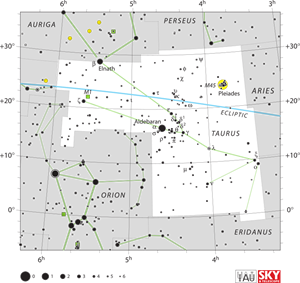
The Taurus constellation represents the bull of our night sky. With an area of 797 square degrees, it is the 17th largest constellation overall. It has a northern declination and is best visible in the cold evenings of January.
Early in the Bronze Age, this constellation marked the vernal equinox. Because of Earth’s precession, it moved to Aries, and now it is in Pisces.
Taurus contains many interesting stars and deep-sky objects. The brightest star in the constellation is the red giant Aldebaran, which is also the 14th brightest star in our night sky. It is followed by the peculiar bluish star Elnath.
The famous Pleiades star cluster or “seven sisters” is in the constellation of Taurus. It is visible to the unaided eye and, with its form, is sometimes mistaken for the Little Dipper. Another naked-eye object in the constellation is the Hyades. It is the closest star cluster to us. The Pleiades and the Hyades are together called the “golden gate of the ecliptic.”
In Greek mythology, Taurus was Zeus who transformed himself into a white bull to kidnap princess Europa. [Learn more about Taurus constellation]
Gemini Constellation
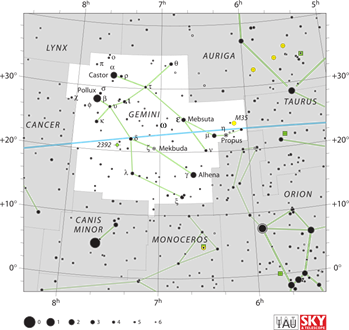
The Gemini constellation represents the celestial twin who are, in mythology, Castor and Pollux. It is located in the northern celestial hemisphere and is seen in the winter months of December to January.
The orange giant Pollux shines the brightest in the constellation. It is followed by the sextuple star system of Castor. The open clusters Messier 35 and NGC 2158 are located in Gemini. The amazing Eskimo Nebula and Medusa Nebula are just some of the enchanting deep-sky objects in the constellation.
The Geminids meteor shower from the asteroid 3200 Phaethon radiates in Gemini. It is a rich light show that produces around 100 meteors per hour.
In Greek mythology, Castor and Pollux are twins but they have different fathers. Their mother, Leda, was seduced by Zeus and so the god fathered Pollux. On the other hand, king Tyndareus was the father of Castor.
When the mortal twin, Castor, died, Pollux asked Zeus to make his brother immortal. Zeus united the twins for eternity and turned them into stars. [Learn more about Gemini constellation]
Cancer Constellation

Cancer the Crab is a zodiac constellation located in the northern sky. With an area of 506 square degrees, it is the 31st largest constellation overall. It is located between Gemini and Leo in the ecliptic.
The stars that make up the Cancer constellation are not very bright. Its brightest star, Tarf, has an apparent magnitude of only 3.5. About ten stars in the constellation are discovered to have planetary systems.
Located at the heart of this constellation is Praesepe or the Beehive Cluster—an open cluster about 600 light-years from us. Messier 67 or the King Cobra Cluster is another deep-sky object in the area.
In Greek mythology, the constellation of Cancer is the crab that Heracles fought in one of his Twelve Labors. The hero defeated the crab so Hera put it in the sky. [Learn more about Cancer constellation]
Leo Constellation
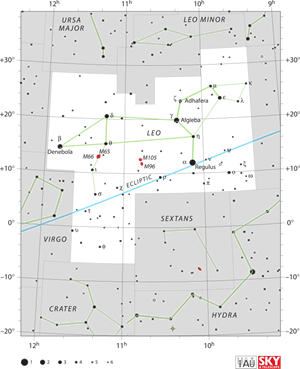
Leo is a prominent constellation that lies in the northern sky. It is the 12th largest constellation that spans an area of 947 square degrees. The celestial lion is one of the easiest objects to spot because of its sickle-like pattern.
This constellation has several bright stars within its vicinity, four of which shine in the first and second magnitude. The brightest star is the bluish star Regulus. It is followed by Denebola, Algieba, and Zosma.
Many galaxies are in the Leo constellation. The Leo Triplet, the Leo Ring, and the spiral galaxies Messier 95 and Messier 96 are some of the interesting deep-sky objects in the area. Large quasar groups are also located in the constellation.
In Greek mythology, Leo represents the Nemean Lion that Heracles killed in one of his Twelve Labors. [Learn more about Leo constellation]
Virgo Constellation
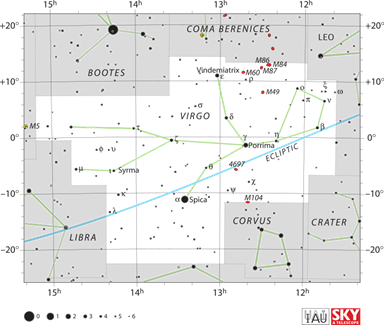
Virgo is a very large constellation that spans 1,294 square degrees. With that area, it is the second-largest among the 88 constellations, with Hydra being the first. It is located between the zodiac constellations Leo and Libra in the ecliptic.
Because it is a large constellation, the Sun travels the longest in Virgo. It is most visible during spring nights in the northern sky. We can spot it through the nearby bright star Arcturus in the Boötes constellation.
The brightest star in Virgo is the binary star Spica, which is also a part of the Spring Triangle asterism. Zavijava, Porrima, and Vindemiatrix are just some of the bright stars in the constellation. So far, more than 30 exoplanets have been discovered to surround the stars of Virgo.
Virgo the Maiden is host to many deep-sky objects. In fact, the largest galaxy in this constellation, Messier 87, was the site of the first image taken of a black hole. The famous Sombrero galaxy is also located in this constellation.
Virgo is connected to many goddesses in different mythologies. It is said that she represents the goddess of justice, Dike. She is also said to be Persephone, the abducted daughter of Demeter. [Learn more about Virgo constellation]
Libra Constellation
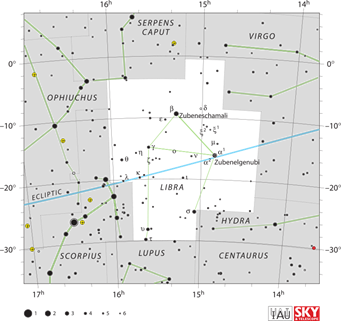
Libra is Latin for “weighing scales.” It is the 29th largest constellation with an area of 538 square degrees. It is located in the southern sky between the zodiac constellations of Virgo and Scorpius in the ecliptic.
Though it is large, Libra does not have first-magnitude stars. Its brightest point, Zubeneschamali (Beta Librae), has an apparent magnitude of 2.6. All in all, about 80 stars in the constellation are within the 6.5-magnitude naked eye limit.
The globular cluster NGC 5897 can be found in the Libra constellation. The barred spiral NGC 5792 and the lenticular galaxy NGC 5890 are other deep-sky objects in Libra.
In mythology, the constellation of Libra is related to Themis, the Greek goddess of justice. It is also said that the constellation symbol are the scales that Astraea held. [Learn more about Libra constellation]
Scorpius Constellation
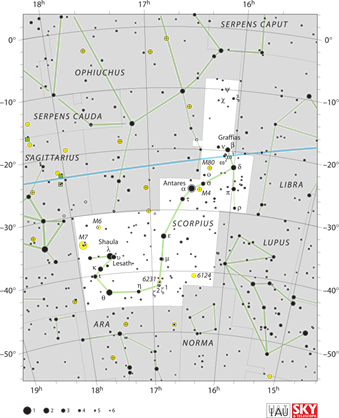
Scorpius represents the celestial scorpion. It was one of the first 48 constellations identified by Ptolemy. It is the 33rd largest constellation overall and has an area of 497 square degrees.
Scorpius is located in the southern celestial hemisphere. It is easily recognized because its bright stars form a hook-like pattern, just like a scorpion’s tail.
The red supergiant Antares is the brightest star in the constellation of Scorpius. This star’s name means “rival of Mars” because of its reddish color. Other distinct stars in the constellation are Acrab, Dschubba, Jabbah, and Fang.
The Scorpius constellation is rich in deep-sky objects because the Milky Way passes through it. Some of the most notable objects in the area are the Butterfly Cluster, the Ptolemy Cluster, and the Bug Nebula.
In Greek mythology, it was said that the hunter Orion boasted to the gods that he would slay all animals on Earth. The Earth goddess Gaia got angry about this and sent a scorpion to kill the hunter. [Learn more about Scorpius constellation]
Ophiuchus Constellation
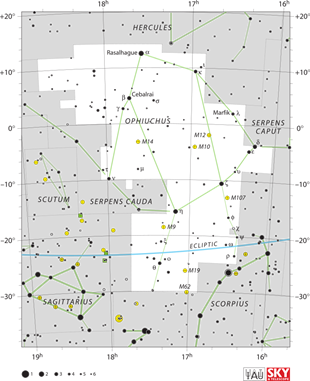
Ophiuchus is the 11th largest constellation. It represents the “serpent bearer” holding the Serpens constellation. Though the the Sun passes through it, it is often not recognized as a zodiac constellation.
Ophiuchus is located in the celestial equator. It lies near Sagittarius and Libra in the ecliptic. The best time to see it in the the northern hemisphere is during summer nights.
The alpha star in the Ophiuchus constelaltion is Rasalhague, which means “head of the serpent charmer.” Other notable stars are Sabik, Cebalrai, and Marfik. This constellation contains many star clusters like Messier 9 and Messier 10. NGC 6240 or the Starfish Galaxy is also in this constellation.
In Western astrology, Ophiuchus is sometimes referred to as the “13th zodiac,” but no zodiac sign is related to it. In ancient Greek mythology, it is said to represent either the god Apollo or Asclepius the god of medicine. [Learn more about Ophiuchus constellation]
Sagittarius Constellation
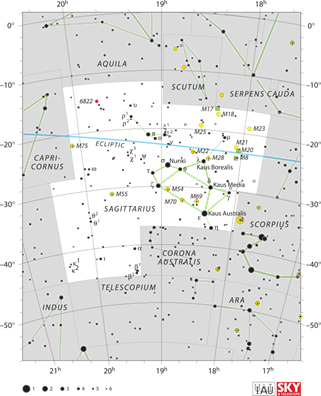
Sagittarius is a southern sky constellation that represents the celestial archer. It has a prominent sky pattern known as the “Teapot asterism.” From this pattern, we can see the hazy Milky Way galaxy looking like steam coming from this teapot.
The binary star system of Kaus Australis is the brightest star in the constellation of Sagittarius. Other notable stars are Rukbat, Nunki, Ascella, and Kaus Meridionalis.
Many interesting deep-sky objects are in Sagittarius because the galactic center lies in it. The Large Sagittarius Star Cloud and Small Sagittarius Star Cloud are two of the most notable objects in the constellation. Examples of nebulosities are Lagoon Nebula, Omega Nebula, and the Red Spider Nebula.
Sagittarius is represented as a centaur. Some sources link it to Chiron, though the famous centaur is also related to the Centaurus constellation. [Learn more about Sagittarius constellation]
Capricornus Constellation
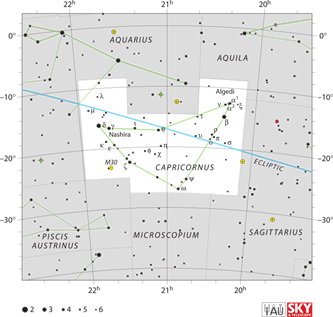
Capricornus is a zodiac constellation that represents the celestial Sea Goat. With an area of 414 square degrees, it is the 40th largest constellation overall. However, it is the smallest of the 13th zodiac constellations.
It is not a bright constellation and its brightest star, Deneb Algedi, is only of 2.9 apparent magnitude. Though not extraordinarily bright, Alpha Capricorni, Dabih, and Nashira are other naked-eye stars in the Capricornus constellation.
The star cluster Messier 30 and the HCG 87 group of galaxies are some of its deep-sky objects.
Several Greek myths are associated with Capricornus. One of which is the she-goat Amalthea that suckled Zeus when he was an infant. Another was that it was a Sea-Goat. The constellation is also linked to Pan, a deity who is half man-half goat. [Learn more about Capricornus constellation]
Aquarius Constellation
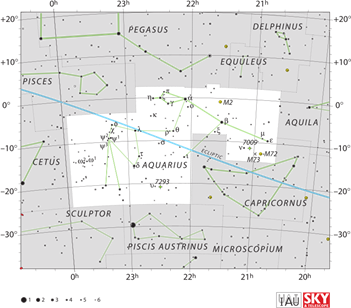
Aquarius symbolizes the celestial Water Bearer. It is the 10th largest constellation overall, having an area of 980 square degrees. As one of the zodiacs, it lies in ecliptic between Pisces and Capricornus.
The brightest star in the constellation of Aquarius is Sadalsuud (Beta Aquarii), whose apparent magnitude is 2.87. Its second-brightest point is the supergiant Sadalmelik.
A rare deep sky object called a green bean galaxy (J2240) was discovered in the Aquarius constellation. It also contains globular clusters like Messier 2, the Saturn Nebula, and the Helix Nebula.
There are two myths associated with Aquarius. The first one was that it was Ganymede, the cupbearer of the gods. A different story relates it Deucalion who is Prometheus’s son. [Learn more about Aquarius constellation]
Pisces Constellation
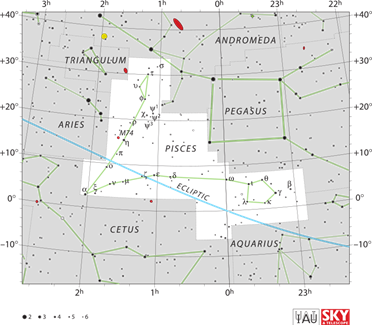
The constellation of Pisces represents two fish connected by a cord. It is one of the oldest recognized constellations that can be traced back to Greco-Roman antiquity. It is the 14th largest constellation in the night sky.
At present, the March equinox starts in Pisces. This means that when the Sun enters this constellation, vernal/spring equinox starts in the northern hemisphere. Meanwhile, it signals the autumnal equinox in the Southern Hemisphere.
Though it does not have the alpha designation, Alpherg (Eta Piscium) is the brightest star in the Pisces constellation. Othe notable stars include Alrescha, Fumalsamakah, and Van Maanen’s Star—the closest white dwarf known. Some of the interesting deep-sky objects in Pisces are Messier 74, NGC 488, and the colliding galaxies collectively called NGC 520.
The myth related to Pisces involves Aphrodite and her son Eros. It was said that the two got left at Mount Olympus as Typhon tried to take over the kingdom. Zeus helped them by turning them into fish to fool Typhon. Aphrodite and Eros made sure they would not separate by tying their tails together.
[Learn more about Pisces constellation]
Chinese Zodiac and Western Zodiac: What’s the Difference?
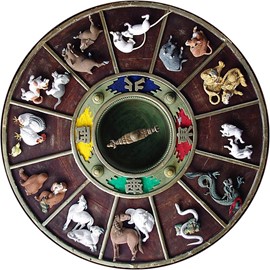
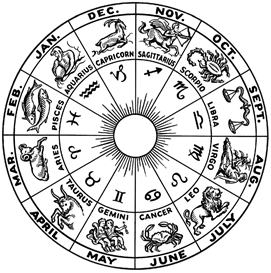
Both the Chinese and the Western zodiac have 12 signs. These signs are determined by the month and year of your birth. In astrology, it is believed that these signs will reveal a lot about a person’s personality and that these will serve as guides to a person’s life.
Though they have some similarities, these two areas of astrology have are represented by different signs. They also have different basis for each system.
In terms of origin, it is said that the 12 signs of the Chinese zodiac were derived from when the calendar was being developed. In a myth, it was said that all the animals on Earth were called to participate in a race. From this, the first 12 animals to reach the finish line became the basis of the Chinese zodiac signs.
In Western astrology, the astrological signs were based on the 12 constellations along the ecliptic or the Sun’s path. These 12 signs corresponds to the 12 months in a year.
The 12 signs of the Chinese zodiac corresponds to a year each, as part of a 12-year cycle. Though the Chinese signs are assigned by year, there are also animals signs by months, days, and hours. They are called “inner animals,” “true animals,” and “secret animals,” respectively.
The western zodiac is different because its basis is the alignment of celestial objects like the stars, moons, and planets.
While the Chinese zodiac starts with the Rat sign, the first constellation of the western zodiac is Aries the Ram.
In Astrology: The 12 Zodiac Signs
| 12 ZODIAC SIGNS | |
|---|---|
| Western Zodiac | Chinese Zodiac |
| 1. Ram | 1. Rat |
| 2. Bull | 2. Ox |
| 3. Twins | 3. Tiger |
| 4. Crab | 4. Rabbit |
| 5. Lion | 5. Dragon |
| 6. Virgin | 6. Snake |
| 7. Scales | 7. Horse |
| 8. Scorpion | 8. Goat |
| 9. Centaur | 9. Monkey |
| 10. Sea-Goat | 10. Rooster |
| 11. Water Bearer | 11. Dog |
| 12. Fish | 12. Pig |
The signs of the Chinese and the western zodiacs do not correspond to each other because these systems are based on different things. Still, with these signs side by side, we cannot help but see the similarities with the Bull/Ox and the Ram/Goat signs.
| THE 12 WESTERN ZODIAC SIGNS | ||
|---|---|---|
| Sign | Symbol | Date |
| 1. Aries the Ram | ♈︎ | March 21–April 19 |
| 2. Taurus the Bull | ♉︎ | April 20–May 20 |
| 3. Gemini the Twins | ♊︎ | May 21–June 21 |
| 4. Cancer the Crab | ♋︎ | June 22–July 22 |
| 5. Leo the Lion | ♌︎ | July 23–August 22 |
| 6. Virgo the Virgin | ♍︎ | August 23–September 22 |
| 7. Libra the Balance | ♎︎ | September 23–October 23 |
| 8. Scorpius the Scorpion | ♏︎ | October 24–November 21 |
| 9. Sagittarius the Archer | ♐︎ | November 22–December 21 |
| 10. Capricornus the Goat | ♑︎ | December 22–January 19 |
| 11. Aquarius the Water Bearer | ♒︎ | January 20–February 18 |
| 12. Pisces the Fish | ♓︎ | February 19–March 20 |
More Facts About the Zodiac Constellations
- Virgo is the largest zodiac constellation while Capricornus is the smallest. Meanwhile, Cancer is the faintest.
- Scorpius is a large constellation but the Sun only takes about a week to travel through it. This is because the ecliptic passes through the smaller part of the constellation boundary. It has the shortest solar stay among all the zodiac constellations.
- The zodiac constellations do not rise above the horizon when the Sun is passing through them. Conversely, they can be seen the whole night when the Sun is at opposition or on the opposite side of the celestial sphere.
- The zodiac constellations shift slowly because of the precession of the Earth’s orbit. Aries signalled spring about 2,000 years ago but now it is already in Pisces. Even so, many people still call the first day of spring the “First Point of Aries.”
- A unique feature of the Chinese zodiac is that it is believed that a person is unlucky during the year of their animal sign. For example, the zodiac sign of a person born in 1998 is Tiger. That means, they will have bad luck in 2022 which is also the year of the Tiger.
Sources:
https://time.com/5867647/nasa-zodiac-star/
https://www.britannica.com/topic/zodiac
https://www.chinahighlights.com/travelguide/chinese-zodiac/chinese-vs-western-astrology.htm
https://en.wikipedia.org/wiki/Chinese_zodiac#Chinese_calendar
https://en.wikipedia.org/wiki/Zodiac
https://www.constellation-guide.com/constellation-map/zodiac-constellations/
Image Sources:
What Is the Zodiac?: https://spaceplace.nasa.gov/constellations/en/constellations-chart.en.jpg
Pluto’s orbit: https://upload.wikimedia.org/wikipedia/commons/0/0a/Plutoorbit1.5sideview.gif
Map of the Zodiac: https://upload.wikimedia.org/wikipedia/commons/thumb/d/d4/Constellations_ecliptic_equirectangular_plot.svg/1920px-Constellations_ecliptic_equirectangular_plot.svg.png
Chinese zodiac: https://upload.wikimedia.org/wikipedia/commons/thumb/0/07/Chinese_Zodiac_carvings_on_ceiling_of_Kushida_Shrine%2C_Fukuoka.jpg/800px-Chinese_Zodiac_carvings_on_ceiling_of_Kushida_Shrine%2C_Fukuoka.jpg
Western zodiac: https://upload.wikimedia.org/wikipedia/commons/thumb/5/5e/Zodiac_%28PSF%29.png/800px-Zodiac_%28PSF%29.png
